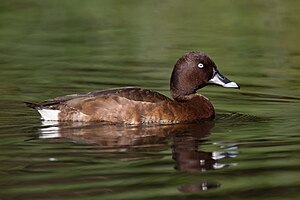Wikipedia:Picture of the day/March 2021
|
Featured picture tools: |
These featured pictures, as scheduled below, appeared as the picture of the day (POTD) on the English Wikipedia's Main Page in March 2021. Individual sections for each day on this page can be linked to with the day number as the anchor name (e.g. [[Wikipedia:Picture of the day/March 2021#1]] for March 1).
You can add an automatically updating POTD template to your user page using {{Pic of the day}} (version with blurb) or {{POTD}} (version without blurb). For instructions on how to make custom POTD layouts, see Wikipedia:Picture of the day.Purge server cache
March 1

|
|
This is a panoramic view of the interior of the Pula Arena, a Roman amphitheatre in Pula, Croatia. Constructed between 27 BC and AD 86, it is among the six largest surviving Roman arenas in the world, and is the best-preserved ancient monument in the country. The amphitheatre appears on the Croatian ten-kuna banknote. Photograph credit: Diego Delso
Recently featured:
|
March 2

|
Les Troyens (The Trojans) is a French grand opera in five acts by Hector Berlioz, with a libretto written by the composer himself based on Virgil's Aeneid. The score was composed between 1856 and 1858, but Berlioz did not live long enough to see the work performed in its entirety. The first two acts were performed separately under the title La Prise de Troie. This picture shows the cover of the first-edition vocal score for La Prise de Troie, published in 1863. Illustration credit: Antoine Barbizet; restored by Adam Cuerden
Recently featured:
|
March 3
|
The hardhead (Aythya australis) is a species of diving duck found in Australia. Also known as the white-eyed duck, its plumage is chocolate brown in both sexes, but only males have the distinctive white eye. The common name "hardhead" has nothing to do with the density of the bird's skull, instead referring to the difficulty encountered by early taxidermists in processing the head. These female (top) and male (bottom) hardheads were photographed at Hurstville Golf Course in Mortdale, New South Wales. Photograph credit: John Harrison
Recently featured:
|
March 4

|
This historical depiction of the coat of arms of Vermont was illustrated by American engraver Henry Mitchell in State Arms of the Union, published in 1876 by Louis Prang. The escutcheon depicts a green landscape, beyond which are high mountains and a yellowish sky; in the center grows a pine tree, between three erect yellow sheaves and a red cow. The state's official motto, "Freedom and Unity", appears below the shield. Illustration credit: Henry Mitchell; restored by Andrew Shiva
Recently featured:
|
March 5
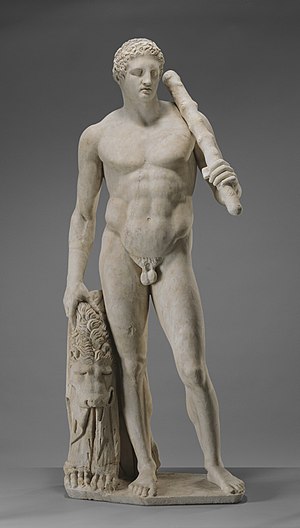
|
The Lansdowne Heracles is a Roman marble sculpture dating from about 125 CE. It represents the hero Heracles as a beardless youth grasping the skin of the Nemean lion with his club upon his shoulder. The statue was discovered in 1790 on the site of Hadrian's Villa in Tivoli, and is now in the collection of the J. Paul Getty Museum's Getty Villa in Malibu, California. Sculpture credit: unknown; photographed by the J. Paul Getty Museum
Recently featured:
|
March 6

|
|
The Palais Galliera, formally known as the Musée de la Mode de la Ville de Paris, is a museum of fashion and fashion history located in the 16th arrondissement of Paris, France. Following the death of her husband in 1876, the Duchess of Galliera gave land and funds for the erection of a museum to house his collection of paintings and fine art that she proposed to give to the state. The building was completed in 1894, but the collections were in fact donated to Genoa, Italy, where they are now displayed at the Palazzo Rosso and the Palazzo Bianco. Photograph credit: Joe deSousa
Recently featured:
|
March 7

|
Mieke Wijaya (born 7 March 1940) is an Indonesian actress who has won three Citra Awards. Photographed here around 1960, she rose to fame as one of the stars in Perfini's musical comedy film Tiga Dara. Her career, spanning five decades, included performing as part of a stage-drama troupe in the 1960s while continuing to act in films, but she mostly concentrated on television roles by the 1990s. Photograph credit: Tati Photo Studio; restored by Chris Woodrich
Recently featured:
|
March 8

|
|
This is a cartoon by the German-American cartoonist and animator Henry Mayer (1868–1954), entitled The Awakening, which first appeared in the magazine Puck in February 1915. Published in support of women's suffrage in the United States, the cartoon depicts Lady Liberty wearing a cape labeled "Votes for Women" and standing astride the states (colored white) that had granted women the right to vote. A poem by Alice Duer Miller is printed beneath. Cartoon credit: Henry Mayer; restored by Adam Cuerden
Recently featured:
|
March 9

|
Philippe Chaperon (1823–1906) was a French painter and scenic designer, known particularly for his work at the Paris Opera. This is Chaperon's set design for the third act of Giuseppe Verdi's Rigoletto for an 1885 production of the opera at the Palais Garnier in Paris. Set design credit: Philippe Chaperon; restored by Adam Cuerden
Recently featured:
|
March 10
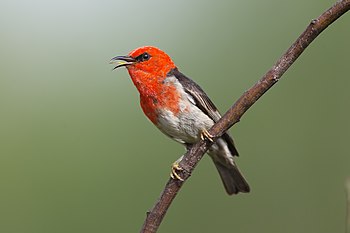
|
The scarlet myzomela (Myzomela sanguinolenta) is a small bird of the honeyeater family Meliphagidae. At about 10 cm (4 in) long, it is the smallest honeyeater in Australia. It has a short tail and relatively long down-curved bill; the male is a striking bright red with black wings, while the female is entirely brown. The bird is more vocal than most honeyeaters, and a variety of calls have been recorded, including a bell-like tinkling. This male scarlet myzomela was photographed in Windsor Downs Nature Reserve, New South Wales. Photograph credit: John Harrison
Recently featured:
|
March 11

|
Bridal Procession on the Hardangerfjord is an 1848 painting by Hans Gude and Adolph Tidemand, considered to be a prime example of Norwegian romantic nationalism. Gude painted the Norwegian landscape and Tidemand the bridal party. In the foreground boat, the groom is depicted tipping his hat, and the bride wears a bridal crown. The boat crew is dressed in typical bunad costumes, and other boats with guests can be seen in the distance. The painting is in the collection of the National Gallery in Oslo. Painting credit: Hans Gude and Adolph Tidemand
Recently featured:
|
March 12
Subpage 1

|
Fractional currency, also referred to as shinplasters, was introduced by the United States federal government following the outbreak of the Civil War. These low-denomination banknotes of the United States dollar were in use between 1862 and 1876, and issued in denominations of 3, 5, 10, 15, 25, and 50 cents across five issuing periods. This ten-cent fourth-issue banknote depicts a personification of Liberty on the obverse. The fourth issue had additional anti-counterfeiting measures in the form of watermarked paper, the embedding of large silk fibers, and blue-tinted end paper. This banknote is in the Smithsonian Institution's National Numismatic Collection. Other denominations:Banknote design credit: Bureau of Engraving and Printing; scanned by Andrew Shiva
Recently featured:
|
Subpage 2

|
Fractional currency, also referred to as shinplasters, was introduced by the United States federal government following the outbreak of the Civil War. These low-denomination banknotes of the United States dollar were in use between 1862 and 1876, and issued in denominations of 3, 5, 10, 15, 25, and 50 cents across five issuing periods. This fifteen-cent fourth-issue banknote depicts a personification of Columbia on the obverse. The fourth issue had additional anti-counterfeiting measures in the form of watermarked paper, the embedding of large silk fibers, and blue-tinted end paper. This banknote is in the Smithsonian Institution's National Numismatic Collection. Other denominations:Banknote design credit: Bureau of Engraving and Printing; scanned by Andrew Shiva
Recently featured:
|
Subpage 3

|
Fractional currency, also referred to as shinplasters, was introduced by the United States federal government following the outbreak of the Civil War. These low-denomination banknotes of the United States dollar were in use between 1862 and 1876, and issued in denominations of 3, 5, 10, 15, 25, and 50 cents across five issuing periods. This twenty-five-cent fourth-issue banknote depicts President George Washington on the obverse. The fourth issue had additional anti-counterfeiting measures in the form of watermarked paper, the embedding of large silk fibers, and blue-tinted end paper. This banknote is in the Smithsonian Institution's National Numismatic Collection. Other denominations:Banknote design credit: Bureau of Engraving and Printing; scanned by Andrew Shiva
Recently featured:
|
Subpage 4

|
Fractional currency, also referred to as shinplasters, was introduced by the United States federal government following the outbreak of the Civil War. These low-denomination banknotes of the United States dollar were in use between 1862 and 1876, and issued in denominations of 3, 5, 10, 15, 25, and 50 cents across five issuing periods. This fifty-cent fourth-issue banknote depicts President Abraham Lincoln on the obverse. The fourth issue had additional anti-counterfeiting measures in the form of watermarked paper, the embedding of large silk fibers, and blue-tinted end paper. This banknote is in the Smithsonian Institution's National Numismatic Collection. Other denominations:Banknote design credit: Bureau of Engraving and Printing; scanned by Andrew Shiva
Recently featured:
|
Subpage 5

|
Fractional currency, also referred to as shinplasters, was introduced by the United States federal government following the outbreak of the Civil War. These low-denomination banknotes of the United States dollar were in use between 1862 and 1876, and issued in denominations of 3, 5, 10, 15, 25, and 50 cents across five issuing periods. This fifty-cent fourth-issue banknote depicts Secretary of War Edwin Stanton on the obverse. The fourth issue had additional anti-counterfeiting measures in the form of watermarked paper, the embedding of large silk fibers, and blue-tinted end paper. This banknote is in the Smithsonian Institution's National Numismatic Collection. Other denominations:Banknote design credit: Bureau of Engraving and Printing; scanned by Andrew Shiva
Recently featured:
|
Subpage 6

|
Fractional currency, also referred to as shinplasters, was introduced by the United States federal government following the outbreak of the Civil War. These low-denomination banknotes of the United States dollar were in use between 1862 and 1876, and issued in denominations of 3, 5, 10, 15, 25, and 50 cents across five issuing periods. This fifty-cent fourth-issue banknote depicts Secretary of the Treasury Samuel Dexter on the obverse. The fourth issue had additional anti-counterfeiting measures in the form of watermarked paper, the embedding of large silk fibers, and blue-tinted end paper. This banknote is in the Smithsonian Institution's National Numismatic Collection. Other denominations:Banknote design credit: Bureau of Engraving and Printing; scanned by Andrew Shiva
Recently featured:
|
Subpage 7

|
Fractional currency, also referred to as shinplasters, was introduced by the United States federal government following the outbreak of the Civil War. These low-denomination banknotes of the United States dollar were in use between 1862 and 1876, and issued in denominations of 3, 5, 10, 15, 25, and 50 cents across five issuing periods. This ten-cent fifth-issue banknote depicts Secretary of the Treasury William M. Meredith on the obverse. The fifth issue had additional anti-counterfeiting measures in the embedding of large silk fibers and blue-tinted end paper. This banknote is in the Smithsonian Institution's National Numismatic Collection. Other denominations:Banknote design credit: Bureau of Engraving and Printing; scanned by Andrew Shiva
Recently featured:
|
Subpage 8

|
Fractional currency, also referred to as shinplasters, was introduced by the United States federal government following the outbreak of the Civil War. These low-denomination banknotes of the United States dollar were in use between 1862 and 1876, and issued in denominations of 3, 5, 10, 15, 25, and 50 cents across five issuing periods. This twenty-five-cent fifth-issue banknote depicts Secretary of the Treasury Robert J. Walker on the obverse. The fifth issue had additional anti-counterfeiting measures in the form of the embedding of large silk fibers and blue-tinted end paper. This banknote is in the Smithsonian Institution's National Numismatic Collection. Other denominations:Banknote design credit: Bureau of Engraving and Printing; scanned by Andrew Shiva
Recently featured:
|
Subpage 9

|
Fractional currency, also referred to as shinplasters, was introduced by the United States federal government following the outbreak of the Civil War. These low-denomination banknotes of the United States dollar were in use between 1862 and 1876, and issued in denominations of 3, 5, 10, 15, 25, and 50 cents across five issuing periods. This fifty-cent fifth-issue banknote depicts Secretary of the Treasury William H. Crawford on the obverse. The fifth issue had additional anti-counterfeiting measures in the form of the embedding of large silk fibers and blue-tinted end paper. This banknote is in the Smithsonian Institution's National Numismatic Collection. Other denominations:Banknote design credit: Bureau of Engraving and Printing; scanned by Andrew Shiva
Recently featured:
|
March 13
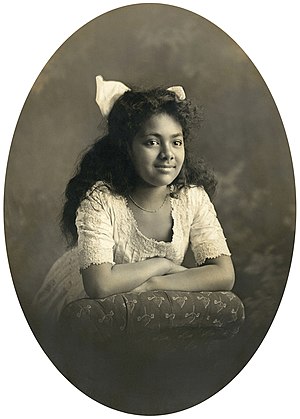
|
Sālote Tupou III (13 March 1900 – 16 December 1965) served as the first queen regnant and the third monarch of Tonga from 1918 until her death in 1965. Photographed here c. 1910 by Herman J. Schmidt, in Auckland, New Zealand, she was the eldest daughter and heir of King George Tupou II of Tonga and his first wife Queen Lavinia Veiongo. Because of the lowly rank of her mother, she was not popular, and was disliked so much that it was unsafe for her to go outside the palace. Photograph credit: Herman John Schmidt, 1872-1959 ; restored by Adam Cuerden
Recently featured:
|
March 14

|
Pope Pius VII (1742–1823) was head of the Catholic Church and ruler of the Papal States from 14 March 1800 to his death in 1823. In this 1819 portrait by Thomas Lawrence, he is shown seated on the papal throne, wearing a zucchetto on his head, a red mozzetta, a lace-trimmed rochet, a white cassock and red papal slippers. The painting is in the Royal Collection of the British royal family, and hangs in the Waterloo Chamber in Windsor Castle. Painting credit: Thomas Lawrence
Recently featured:
|
March 15

|
Andrew Jackson (March 15, 1767 – June 8, 1845) was an American soldier and statesman who served as the seventh president of the United States from 1829 to 1837. He has been widely revered in the United States as an advocate for democracy and the common man, but many of his actions proved divisive, garnering both fervent support and strong opposition from different sectors of society. His reputation has suffered since the 1970s, largely due to his pivotal role in the forcible removal of Native Americans from their ancestral homelands; however, surveys of historians and scholars have ranked Jackson favorably among U.S. presidents. Engraving credit: Bureau of Engraving and Printing; restored by Andrew Shiva
Recently featured:
|
March 16

|
Saint Petersburg, the second-largest city in Russia, is situated at the head of the Gulf of Finland on the Baltic Sea. This photograph shows the eastern end of Vasilyevsky Island, known as the spit, surrounded by the river Neva. The Old Saint Petersburg Stock Exchange and Rostral Columns, built in the Greek Revival style in the first decade of the nineteenth century, are visible in the centre. Photograph credit: Alexander Savin
Recently featured:
|
March 17

|
Eutropis macularia, the bronze grass skink, is a species of lizard in the skink family, Scincidae, native to South and Southeast Asia. It lives in both deciduous and evergreen forests, in plantations, in grasslands, and in rocky areas with scattered trees. The species is active in both the day and the night, feeding on insects and other invertebrates. This bronze grass skink was photographed on a tree trunk on the island of Don Det in Laos. Photograph credit: Basile Morin
Recently featured:
|
March 18

|
Grover Cleveland (March 18, 1837 – June 24, 1908) was an American politician and lawyer who was the 22nd and 24th president of the United States, the only president in American history to serve two non-consecutive terms in office (1885–1889 and 1893–1897). His victory in the 1884 presidential election made him the first successful Democratic nominee since the start of the Civil War. He won praise for his honesty, self-reliance, integrity, and commitment to the principles of classical liberalism, and was renowned for fighting political corruption, patronage, and bossism. Credit: Bureau of Engraving and Printing; restored by Andrew Shiva
Recently featured:
|
March 19

|
Francis B. Spinola (March 19, 1821 – April 14, 1891) was an American politician and military leader of Portuguese and Irish ancestry. He is considered by some authorities as the first Italian American to be elected to the United States House of Representatives, serving as a representative from New York between 1887 and 1891. Spinola also served as a general in the Union Army during the American Civil War. Engraving credit: Bureau of Engraving and Printing; restored by Andrew Shiva
Recently featured:
|
March 20

|
Emily Carr (1871–1945) was a Canadian artist and writer, and one of the first painters in Canada to adopt a Modernist and Post-Impressionist style. She received widespread recognition for her work when she changed from Aboriginal themes to landscapes. This 1939 painting by Carr, entitled Odds and Ends, depicts cleared land and tree stumps, revealing the impact of deforestation on British Columbia, and is now held by the Art Gallery of Greater Victoria. Painting credit: Emily Carr
Recently featured:
|
March 21

|
The Vision of St. John on Patmos is a series of frescoes painted between 1520 and 1522 by the Italian Renaissance artist Antonio da Correggio. Depicting a scene from the Book of Revelation, it occupies the interior of the dome, and the surrounding pendentives, of the Benedictine church of San Giovanni Evangelista in Parma, Italy. Painting credit: Antonio da Correggio; photographed by Livioandronico2013
Recently featured:
|
March 22

|
Abolhassan Banisadr (born 22 March 1933) is an Iranian politician. He was the first president of Iran after the 1979 Iranian Revolution abolished the Pahlavi dynasty, serving from 4 February 1980 until his impeachment by the Islamic Consultative Assembly, the Iranian parliament, on 20 June 1981. Prior to his presidency, he was the Minister of Foreign Affairs in the interim government. Following Banisadr's exile in 1981, he has resided for many years in France, where he co-founded the National Council of Resistance of Iran. Photograph credit: Christoph Braun
Recently featured:
|
March 23

|
Roger B. Chaffee (1935–1967) was an American naval officer and aviator, aeronautical engineer, and NASA astronaut. He was to have been a pilot on Apollo 1, but died in a fire on January 27, 1967, with fellow astronauts Gus Grissom and Ed White, during a pre-launch test for the mission. He was posthumously awarded the Congressional Space Medal of Honor. This photograph shows Chaffee at a console at NASA's Mission Control Center in Houston during the Gemini 3 mission on March 23, 1965. Photograph credit: NASA
Recently featured:
|
March 24

|
The noisy pitta (Pitta versicolor) is a species of bird in the pitta family, Pittidae, found in eastern Australia and southern New Guinea, where it mainly occurs in rainforest, but sometimes in drier woodland and scrub. It is a shy bird, and its distinctive call is heard more often than the bird is seen. It forages on the forest floor, bobbing its head up and down and flicking its tail, searching for insects, woodlice, snails and other invertebrates. Its diet includes some fruit, and it cracks open the shells of molluscs on an anvil. This noisy pitta was photographed in Kembla Heights, New South Wales. Photograph credit: John Harrison
Recently featured:
|
March 25

|
Le mage is an opera in five acts by Jules Massenet to a French libretto by Jean Richepin. First performed at the Paris Opera in 1891, it has rarely been performed since its premiere run of 31 performances, and is one of Massenet's least-known operas. A rare complete concert performance took place at the Massenet Festival in Saint-Étienne in 2012. This poster by Alfredo Edel was produced for the opera's premiere on 16 March 1891. Poster credit: Alfredo Leonardo Edel; restored by Adam Cuerden
Recently featured:
|
March 26
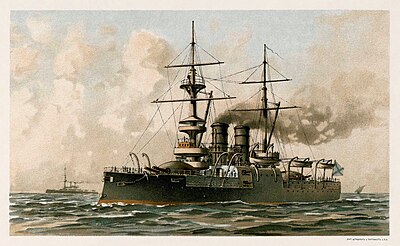
|
Dvenadsat Apostolov was a pre-dreadnought battleship built for the Imperial Russian Navy, the sole ship of her class. Launched in 1890, she entered service with the Black Sea Fleet in 1893, taking part in the failed attempt to recapture the mutinous battleship Potemkin in 1905. Decommissioned and disarmed in 1911, she was used as a stand-in for the title ship during the 1925 filming of the Battleship Potemkin before finally being scrapped in 1931. Lithograph credit: Stadler and Pattinot, after Vasily Ignatius; restored by Adam Cuerden
Recently featured:
|
March 27

|
Chromostereopsis is a visual illusion in which the impression of depth is conveyed in two-dimensional color images. This 1564 stained-glass window, in the Bielsko-Biała Museum and Castle in Poland, exhibits this effect, with contrasting depth perception in the red and blue areas. The window, an example of Standesscheibe, depicts the coat of arms of Unterwalden, a canton of the Old Swiss Confederacy. Stained-glass credit: unknown; photographed by Jan Mehlich
Recently featured:
|
March 28

|
|
The Birds' Head Haggadah is the oldest surviving illuminated manuscript of the Haggadah, a ritual text recounting the story of Passover, the liberation of the Israelites from slavery in ancient Egypt, recited by participants at a Seder. The Ashkenazi Jewish manuscript was produced in the Upper Rhine region of Southern Germany in the early 14th century, with the text copied by a scribe named Menahem. All Jewish men, women, and children depicted in the manuscript have human bodies with the faces and beaks of birds, while non-Jewish and non-human faces are blank or blurred. Numerous theories have been advanced to explain the unusual iconography, usually tied to Jewish aniconism. The manuscript was owned by the German politician Ludwig Marum in the 20th century, and is now in the possession of the Israel Museum in Jerusalem, where it is on permanent exhibition. Manuscript credit: Menahem; photographed by the Israel Museum
Recently featured:
|
March 29

|
Haliotis laevigata is a species of marine mollusc in the family Haliotidae, endemic to Tasmania and the southern and western coasts of Australia. This picture shows five views of a green H. laevigata shell, 7.5 centimetres (3.0 in) in length. The holes in the shell, characteristic of abalones, are respiratory apertures for venting water from the gills and for releasing sperm and eggs into the water column. Photograph credit: H. Zell
Recently featured:
|
March 30

|
Vincent van Gogh (30 March 1853 – 29 July 1890) was a Dutch Post-Impressionist painter and one of the most famous and influential figures in the history of Western art. In just over a decade, he created about 2,100 artworks, including around 860 oil paintings, most of which date from the last two years of his life. Van Gogh sold few paintings during his lifetime, and was contemporaneously considered a madman and a failure. However, he has attained widespread critical and popular acclaim since the early 20th century, and his works are among the world's most expensive paintings. Van Gogh produced this oil-on-canvas self-portrait in September 1889. One of his several self-portraits, it may have been his last, produced shortly before he left Saint-Rémy-de-Provence in southern France. The work is now in the collection of the Musée d'Orsay in Paris. Painting credit: Vincent van Gogh
Recently featured:
|
March 31

|
The SOCATA TBM (now Daher TBM) is a family of high-performance single-engine turboprop business and utility light aircraft manufactured by Daher. This SOCATA TBM 900 was photographed in flight during the 2015 EAA AirVenture Oshkosh airshow in the U.S. state of Wisconsin. The aircraft features a Pratt & Whitney Canada PT6A-64 engine, and a five-blade carbon-fiber propeller, which increases performance and decreases cabin noise. In a passenger configuration, the pressurized cabin is typically fitted with highly finished interiors, featuring luxury materials such as leather and wood veneers. Photograph credit: Michael Mainiero
Recently featured:
|
Picture of the day archives and future dates


